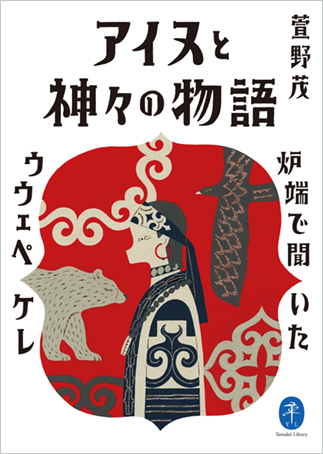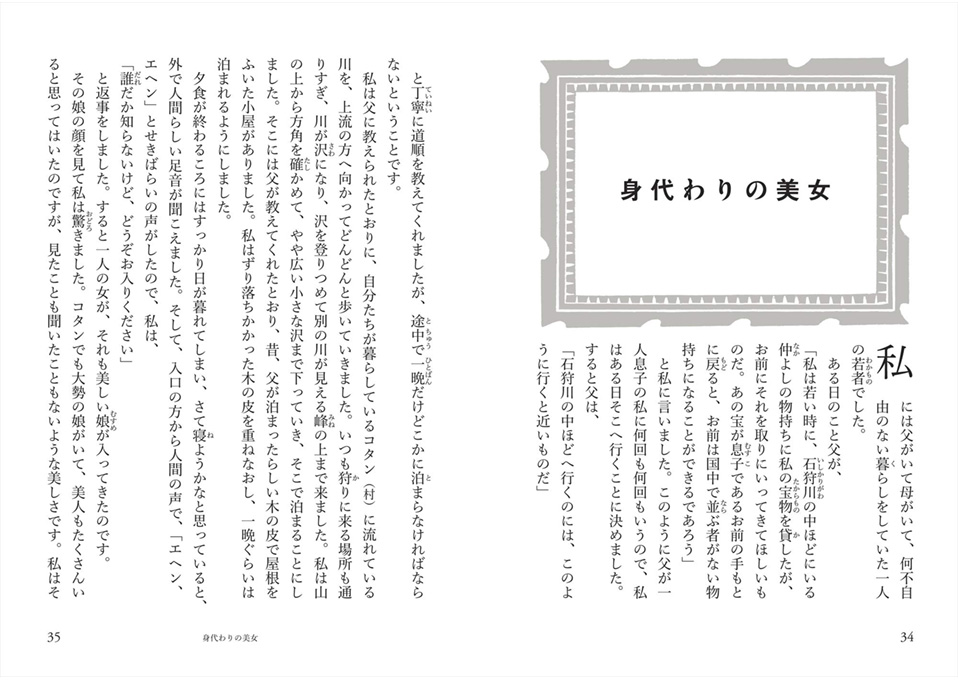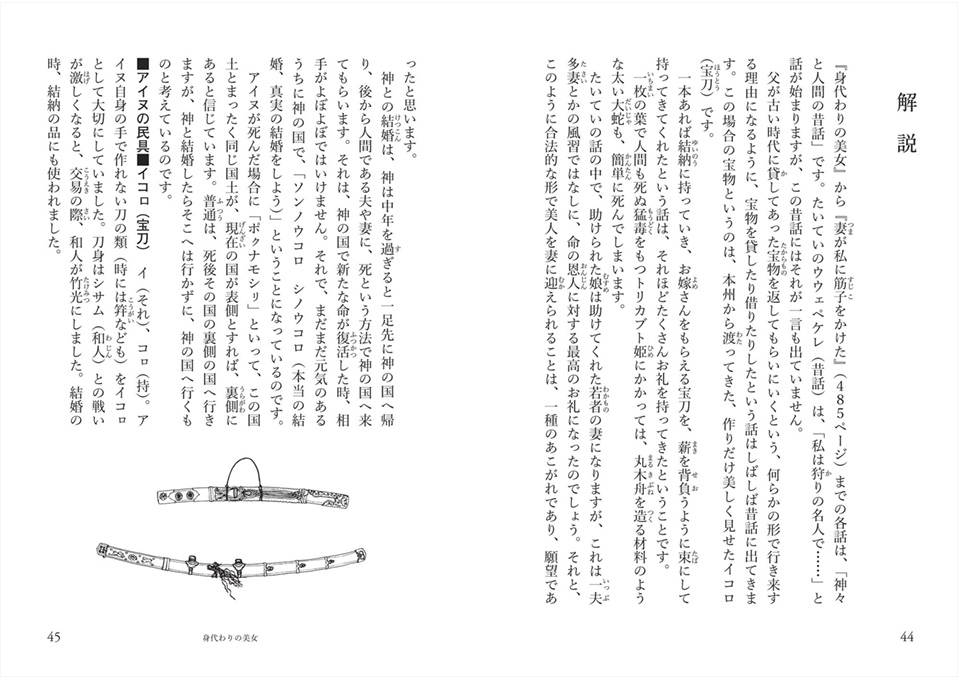This book collects 38 stories and myths handed down among the Ainu, an indigenous people of Japan. Its author was Ainu himself, and visited many elders to collect these stories in the Ainu language before retelling them in Japanese. In Japan, the book is marketed for a general readership, but many of the stories it contains can be enjoyed by small children. Uepeker is often translated into Japanese as mukashi-banashi, meaning “tale of old, folktale”; however, the Ainu have always viewed uepeker as relating the history of their actual experiences as a people. These traditional stories not only conveyed Ainu culture and customs to the next generation, imparting useful life advice and showing how to interact with the kamuy (gods), they were also used to cheer the soul during long winter nights.
The stories contained in the book include “Migawari no bijo” [The Substitute Beauty], “Kaichō to kusuri-mizu” [The Strange Bird and the Medicinal Water], “Karasu to akanbō” [The Crow and the Baby], “Kodomo to asonda kami” [The Kamuy Who Played with Children], “Oni no iwaya” [The Ogre’s Cave], “Kurogitsune no inau” [The Black Fox’s Inaw], “Sanbon-ashi no ōguma” [The Three-Legged Bear], “Suzume no ongaeshi” [The Sparrow’s Gratitude], “Katsura-no-ki no megami” [The Goddess of the Katsura Tree], “Uchide no kozuchi” [The Magical Mallet], and “Kunizukuri-no-kami to fukurō” [The World-Creating Kamuy and the Owl]. Their mood and tone differ from traditional Japanese stories. The name of the person who told each story to the author is noted, and brief commentaries and introductions to traditional implements appearing in the stories are included after each story. Each commentary includes an explanation of the story’s meaning in the context of Ainu society, the author’s recollections of the person who told it, explanations about the gods appearing in the story, and an overview of what the story teaches to children. The introductions to traditional implements feature handcrafted items that see everyday use, with illustrations and information about their purpose and the materials used to make them.
The Ainu have maintained a respectful relationship with nature since time immemorial, regarding the bear and other animals and plants as deities. There is much we can learn today from their traditional tales and worldview. (SY)
The stories contained in the book include “Migawari no bijo” [The Substitute Beauty], “Kaichō to kusuri-mizu” [The Strange Bird and the Medicinal Water], “Karasu to akanbō” [The Crow and the Baby], “Kodomo to asonda kami” [The Kamuy Who Played with Children], “Oni no iwaya” [The Ogre’s Cave], “Kurogitsune no inau” [The Black Fox’s Inaw], “Sanbon-ashi no ōguma” [The Three-Legged Bear], “Suzume no ongaeshi” [The Sparrow’s Gratitude], “Katsura-no-ki no megami” [The Goddess of the Katsura Tree], “Uchide no kozuchi” [The Magical Mallet], and “Kunizukuri-no-kami to fukurō” [The World-Creating Kamuy and the Owl]. Their mood and tone differ from traditional Japanese stories. The name of the person who told each story to the author is noted, and brief commentaries and introductions to traditional implements appearing in the stories are included after each story. Each commentary includes an explanation of the story’s meaning in the context of Ainu society, the author’s recollections of the person who told it, explanations about the gods appearing in the story, and an overview of what the story teaches to children. The introductions to traditional implements feature handcrafted items that see everyday use, with illustrations and information about their purpose and the materials used to make them.
The Ainu have maintained a respectful relationship with nature since time immemorial, regarding the bear and other animals and plants as deities. There is much we can learn today from their traditional tales and worldview. (SY)






